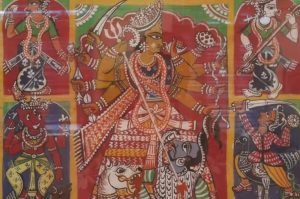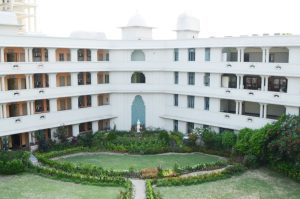Exhibition at Ramakrishna Mission: Kolkata, the cultural capital of India, has once again found itself at the confluence of spirituality, art, and history with the opening of an extraordinary exhibition titled “Mahamaya” at the Ramakrishna Mission Institute of Culture (RMIC), Golpark. Organized in the run-up to Durga Puja, this three-day exhibition offers an evocative exploration of the timeless legacy of Goddess Durga, presenting her as more than just a divine figure of worship—she is a cultural icon, a symbol of resilience, and the embodiment of feminine power across centuries.

The RMIC, known for its heritage and its commitment to cultural and spiritual education, has transformed its museum and gallery spaces into a reflective journey of the Divine Mother. “Mahamaya,” meaning “Great Illusion” or the cosmic force that governs the universe, serves as the unifying theme of this exhibition. Through carefully curated displays of artifacts, manuscripts, ritual objects, sculptures, and paintings, the exhibition invites visitors to go beyond festive celebrations and engage with the deeper spiritual and cultural meanings of Durga.
The Heritage of RMIC
The Ramakrishna Mission Institute of Culture, founded in 1938, is much more than a cultural hub. It stands as a beacon of Vedantic philosophy, interfaith dialogue, and cultural preservation. Located in Golpark, its architectural elegance makes it a landmark in Kolkata. Recognized as a heritage building, the institute is home to a library with thousands of rare books, a museum with historic artifacts, and academic departments devoted to language, philosophy, and cultural studies.


For decades, RMIC has curated exhibitions that connect spirituality with scholarship, art with philosophy, and devotion with dialogue. From showcasing the teachings of Sri Ramakrishna and Swami Vivekananda to highlighting Indian art traditions, it has consistently offered a platform where culture and spirituality converge. The “Mahamaya” exhibition continues this tradition, drawing in devotees, students, researchers, and art lovers alike.
For more on RMIC’s history and vision, visit the official Ramakrishna Mission site.
What Visitors Experience at “Mahamaya”
The exhibition is designed to immerse visitors in the many facets of Goddess Durga. Unlike the grandeur of pandals during Durga Puja, “Mahamaya” is contemplative, scholarly, and spiritually enriching.
Highlights include:
- Art and Iconography: Classical paintings and folk art that showcase Durga in her varied forms—from Mahishasuramardini (slayer of the buffalo demon) to Annapurna (the goddess of nourishment). These artworks trace her evolution across Bengal, Odisha, and beyond.
- Ritual Objects: Conch shells, ceremonial vessels, and centuries-old metal idols that tell stories of devotion across generations.
- Textual Heritage: Rare manuscripts and verses from scriptures like the Devi Mahatmya that celebrate Durga as the cosmic protector.
- Contemporary Narratives: Photographic panels and digital exhibits that reflect how the goddess continues to inspire modern interpretations in literature, cinema, and women’s empowerment movements.
The arrangement of the gallery is deliberately minimalist, allowing each artifact to breathe and enabling visitors to reflect in silence. This atmosphere complements the institute’s mission of offering spiritual learning alongside cultural appreciation.
Durga: More Than a Festival
Durga Puja in Kolkata has earned recognition from UNESCO as part of the Intangible Cultural Heritage of Humanity. The annual festival is celebrated with unmatched grandeur, drawing millions of visitors to the city’s streets. Yet, the deeper essence of Durga’s worship often risks being overshadowed by spectacle.
“Mahamaya” acts as a counterpoint to this, focusing not on the scale of celebration but on the eternal essence of Durga as Mahashakti—the force that destroys evil, nurtures life, and restores balance in the universe.
The exhibition encourages visitors to reflect on how Durga symbolizes both the triumph of good over evil and the resilience of women across cultures. In doing so, it resonates with broader conversations about gender, social justice, and spirituality in contemporary India.
To learn more about Durga Puja’s cultural recognition, explore UNESCO’s Intangible Heritage list.
Cultural and Spiritual Relevance
The timing of the exhibition, just days before Durga Puja, adds to its significance. Visitors are not merely preparing for a festival—they are engaging with its roots, symbolism, and philosophical dimensions.
- For Scholars: The exhibition offers insight into Shaktism and its role in shaping India’s religious identity.
- For Artists: It highlights how goddess imagery has inspired visual, literary, and performing arts for centuries.
- For Devotees: It provides a chance to connect spiritually with the goddess in a meditative space.
- For Citizens: It reminds Kolkata of its role as a cultural capital that not only celebrates festivals but also preserves traditions.
Exhibition at Ramakrishna Mission: The Legacy of Goddess Durga
Across India, Durga has been worshipped in many forms—Durga of Varanasi, Chamundeshwari of Mysuru, and Mahishasuramardini of Bengal. She represents courage, compassion, and protection. In Bengal, especially, she is not just a goddess but a daughter returning home each year, embodying familial warmth alongside divine grandeur.
The exhibition highlights these multiple layers of Durga’s identity:
- The Warrior Goddess who destroys evil forces.
- The Mother who nurtures her children.
- The Cosmic Power who sustains the universe.
This layered identity explains her enduring relevance in art, literature, and everyday worship.
A Model for Cultural Institutions
The “Mahamaya” exhibition underscores the important role of cultural institutions in safeguarding intangible heritage. While pandals are temporary, institutions like RMIC provide continuity, preservation, and scholarly interpretation.
By curating such exhibitions, RMIC ensures that younger generations understand Durga not only as a festival idol but as a symbol of India’s cultural and spiritual fabric.
Similar initiatives, like the Indian Museum’s exhibition “Durga: The Divine Power”, have also contributed to this larger project of cultural preservation. You can explore details at Indian Museum Kolkata.
Conclusion
The “Mahamaya” exhibition at the Ramakrishna Mission Institute of Culture is more than an art show—it is a journey into the essence of the Divine Mother. It blends scholarship, devotion, and cultural appreciation, offering an enriching alternative to the grandeur of pandals.
By celebrating Durga as both goddess and cultural icon, RMIC reaffirms its role as a custodian of India’s spiritual and cultural legacy. For visitors, it is not just an exhibition but an invitation to see Durga with new eyes: as a timeless force who continues to inspire resilience, creativity, and devotion.
Also read: Home | Channel 6 Network – Latest News, Breaking Updates: Politics, Business, Tech & More

